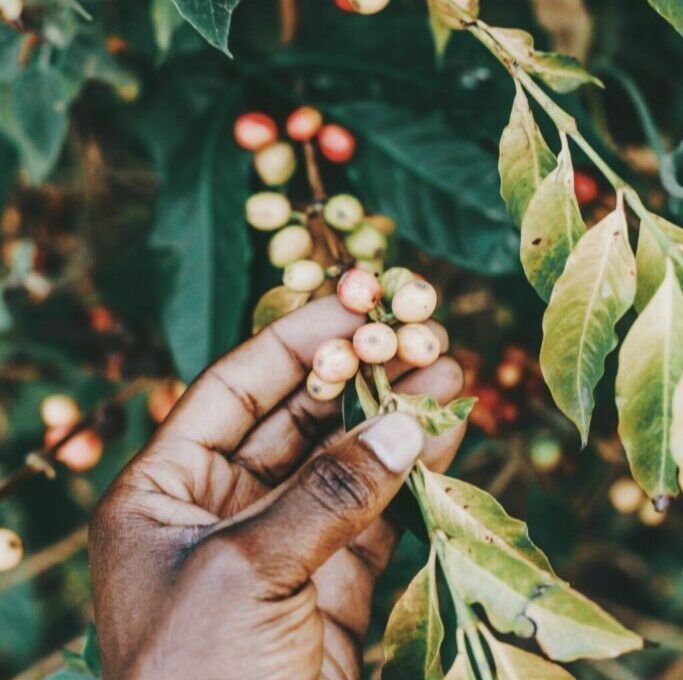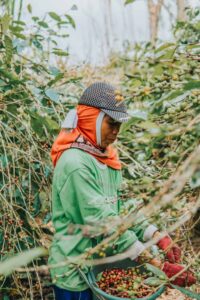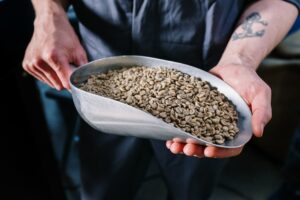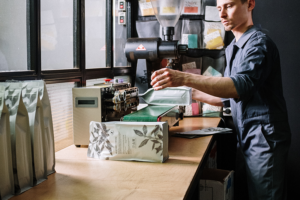1. ORIGIN
How does the coffee process work? There are various legends about where coffee originally came from, but it is generally believed that it all began in Ethiopia. Today, coffee plantations can be found in many tropical countries from South America through Africa to Asia. Most of the production is located around the equator in countries such as Brazil, Ethiopia, India and Vietnam. Each country produces its own coffee taste and even within a geographical area the taste can differ due to the soil, the altitude, the specific microclimate, etc. Mokafina coffee beans come mainly from Brazil, Guatemala, Ethiopia, India and Indonesia.

2. THE COFFEE PLANT
Coffee beans in unprocessed form are the drupes of the coffea bush (coffee plant). There are more than 60 different species of this plant worldwide, but the most widely cultivated are those that produce Arabica, Robusta and Liberica coffee beans. The most popular of these 3 is the Arabica coffee, which is mainly found in Brazil, the largest producer of coffee in the world.
There are already several programmes in place to ensure that the coffee beans roasted at our facility come from fair trade sources. Mokafina sees to the selection process of the beans in the countries of origin. By keeping the line between plantation and coffee roastery as short as possible, and closely monitoring the entire process, we can provide additional guarantees that the basic product of the various coffees comes from fair trade. Mokafina also pursues its own local and social policies.
3. COFFEE BEANS
The beans of the various coffee plants have their own shape, colour and especially taste. The processing of the picked beans differs from country to country and from variety to variety. This further enhances the possible differences in taste, even between the same type of bean from different areas. One big difference in processing is whether or not the coffee beans are ‘washed’. With washed coffee, the beans undergo a process of fermentation by being placed in a water tank for a certain time (24 to 72 hours) together with their cherry flesh to ferment. After this fermentation, the fine-skinned beans are dried in the sun or in drying ovens. Then the last skin is removed and the coffee beans can be prepared for export. In addition to the “washed process”, there is also the “natural process”. This means that after picking, the red, ripe coffee cherries are simply laid out in the sun to dry. The cherry will then become hard and will be crushed carefully. The beans are then released and the dried shells are manually separated from the coffee. Then the coffee beans can be prepared for export. This process is used mainly in Brazil for Santos arabica coffee. This coffee is the basis of most blends with washed arabicas. In most Robusta producing countries (Vietnam, Indonesia, West Arfika) this process is also used because of the lower production cost. These coffees are much heavier in flavour but provide the necessary spiciness in the blends.
4. THE SELECTION
As with wine, each harvest and processing of coffee beans is subject to different factors that influence the taste. The same type of coffee bean can therefore differ greatly in taste. To guarantee the best quality, a sample of each batch of coffee is always tested and tasted before it is transported to the coffee roaster. This quality check will be repeated a few times before the coffee finally reaches the roaster.

5. TRANSPORT
Batches of coffee beans that are approved after the first quality check are packed and transported in traditional jute sacks of 60 to 70 kg. Transporting them in jute sacks is not a nostalgic thing, as jute is an ideal material for preventing rotting because the beans are not completely sealed off. The bags are stacked in such a way that sufficient ventilation is always possible. One container carries between 275 and 320 bales. Once they arrive in the port of Antwerp, the same lots of coffee beans are subjected to a new quality check. These checks consist of roasting and tasting some of the beans. In this way, the shape, colour and taste of the beans can be checked to ensure that they are of good quality and the same beans as those previously tested from the country of origin.
In order to make coffee without caffeine, the caffeine is already extracted from the green (or unprocessed) coffee bean. The caffeine can be “dissolved” from the coffee beans in various ways, but the result is an unroasted bean without caffeine. The dried caffeine is so concentrated that a small teaspoon of it is lethal to humans. Depending on the exact origin or variety, a coffee bean can contain between 0.8 and 2.5% caffeine.

6. MIXING
Many coffees are blends of different coffee beans. As each batch of beans may differ from the previous one, the taste difference must be precisely determined in order to determine the right proportions of the different beans to guarantee an identical final product. Even for coffee that consists of only one type of bean, it is necessary to determine the exact taste differences between the different batches of coffee. Once the differences have been identified, the ratio for the various Mokafina products can be determined under the guidance of the master roaster. The whole process is a matter of taste and craftsmanship.
7. ROASTING
Mokafina roasts the (mixed) coffee beans in the traditional way. This means that, just like more than half a century ago, a longer process of (approximately) 14 minutes is used, during which the beans are roasted at a lower temperature. By opting for this longer process, the beans are roasted right to the core, which guarantees much better quality. With shorter belt processes, the beans are often only roasted on the outside, which results in lower quality. After roasting, the beans are immediately cooled and vacuum-packed so that the beans lose nothing of their flavour.
8. DISTRIBUTION
The coffee roasting plant at Mokafina works every day. By spreading the processing, the roasted beans never remain in stock for long and the coffee delivered by Mokafina is always fresh. Once the coffee has been roasted, it can only lose its flavour. The whole process from coffee plantation to processed coffee has been refined by Mokafina over half a century of coffee roasting. The varieties offered by Mokafina today therefore guarantee an authentic, home-grown taste. Every new cup is an experience for the true coffee lover.





